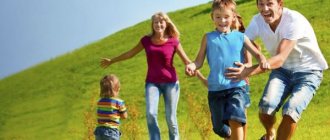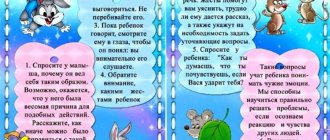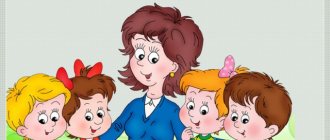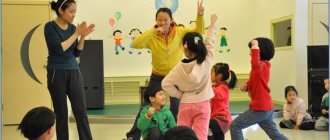Kindergarten project plan. Senior group
Methodological development of a plan for the children's project “Magic Ice”
Information card of the project 1. Full name of the project: “Development of a plan for the children’s project “Magic Ice”. 2. Author of the project (full name): Sidorova Ekaterina Viktorovna 3. Project manager (full name): Sidorova Ekaterina Viktorovna 4. Personnel: teacher, children, parents 5. District, city presenting the project: 6. Organization address: 7. Telephone: 8. Type, type of project: research, includes a child and nature, child performer, project carried out within one age group, frontal, short-term. 9. Purpose, direction of the project: 1) study what conditions are necessary to obtain ice; 2) study why objects slide on ice; 3) to form experimental activities for obtaining colored ice. 10. Summary of the project: children, after the teacher poses a problem, begin collecting information from various sources. After collecting the accumulated material, the teacher invites the children to conduct experimental activities to determine the conditions for the formation of ice, study the properties of the resulting ice, and obtain colored ice at home. 11. Venue: kindergarten, street 12. Dates: any winter month 13. Number of project participants: 13 children, 14 adults. 14. Age of children: 5-6 years 15. Form of implementation: group 16. Expected results (project product): For children: - children will acquire new knowledge about the conditions for the formation of ice and how to obtain it; - will learn to plan, forecast, model, establish relationships in nature, which will allow them to rationally build relationships with the natural environment in the future; — form such personal qualities as curiosity, responsibility towards nature and people; – development of interest in collective, teamwork with all participants in the educational process. For teachers: – self-realization, increasing creative potential; – increasing competence in the use of modern pedagogical technologies in the educational process. For parents: – optimization of parent-child relationships; – creating an atmosphere of trust, mutual understanding and cooperation with all participants in the educational process; – increasing the level of awareness of parents about the activities of preschool educational institutions. Problem: For the comprehensive development of a child’s personality, it is important to introduce him to search and cognitive activities from childhood. It is important to direct the child’s interest to search for the information he needs and ways to achieve the goal of research. During a winter walk with children, the teacher asks the children questions: “What is ice? What kind of ice is there? Why do objects slide on ice? How can you get colored ice? How do people use ice? Objectives: 1. Determine under what conditions ice forms; 2. Investigate the properties of the resulting ice; 3. How can you get colored ice at home? 4. Draw conclusions that we will obtain during our experiments. Presentation form: multimedia presentation “Magic Ice”. Project stages: Stage 1. Introduction of a surprise moment. - while walking with children, the teacher invites children to look at snowflakes, snow and ice (to arouse children’s interest in cognitive activities); — the teacher invites children to ride downhill on sleds and ice skates (to evoke positive emotions in children while sledding); - formulate the problem. “Children, what do you know about the conditions for the formation of ice? Why do objects slide on ice? How can you make colored ice? How is ice obtained industrially? Let us find out about this (children are part of the problem). Stage 2. Collection of information. - Looking at books and illustrations. Searching for information in Internet sources. Surveys of adults (Children, with the help of a teacher, parents, and their own observations, collect information) - Summarizing information through conversation, reading literature and looking at plot illustrations. Stage 3. Conducting experimental activities (Helping children during experimental activities, summarizing the results obtained. Formulate conclusions.) Stage 4 . Drawing up by the teacher, together with the children, of a multimedia presentation “Magic Ice” (to develop children’s skills in working with materials, to teach them to separate the main from the secondary)
We recommend watching:
Project in kindergarten “These different balls” Educational project in kindergarten Summer project on ecology for the middle group of kindergarten Project. Formation of cultural and hygienic skills in children of the 1st junior group
Similar articles:
Creative project in the senior group on the topic “The Mysterious World of Insects”
Pedagogical project in the second junior group of kindergarten
Features of a teacher’s use of the project method in a preschool educational institution
Educational – creative project in the preparatory group “Soon to school”
Pedagogical project in the middle group “Know and follow the road rules!”
Types of projects
What projects can be used in kindergarten? Let's look at the main options:
- creative projects that involve researching a problem and demonstrating the results obtained in the form of a theatrical performance;
- role-playing games, in which, to solve a given problem, children act as characters from a fairy tale;
- creative research projects aimed at solving a problem in the form of a newspaper or design;
- informational and practice-oriented options, which involve children collecting information necessary for group design.
When choosing forms of work, the teacher must take into account the individual age characteristics of preschoolers. Children are characterized by increased physical activity, so projects are associated with play activities.
How it is implemented
Project activities in kindergartens are considered outside the traditional class schedule. Every project requires careful planning and attention to detail. Project activities in kindergarten according to the Federal State Educational Standard are based on the following theoretical principles:
- the focus is on the child;
- children's individual work pace is maintained, so everyone can achieve success;
- basic knowledge is learned more easily because of its versatility.
Why is project activity in children? is the garden always relevant? Because every baby has its own obvious and hidden characteristics, and at every age there are sensitive periods. This direction allows us to take all this into account and create the necessary conditions for the maximum realization of children's potential.
What is GEF?
Project activities in kindergarten according to the Federal State Educational Standard are an interaction between teachers, children and their parents. As a result of working together, children develop cognitive abilities and creative thinking. Children learn to independently search for information and apply it in practice.
When it comes to project work, the teacher must remember that for the child he becomes an equal partner. To create a trusting relationship, the teacher must comply with certain conditions.
- The teacher does the tasks together with the children - this way he makes it clear that they are on the same level. An adult teacher simply demonstrates techniques and observes the children’s activities.
- The child must take part in classes voluntarily. The teacher's task is to interest children in their activities.
- Free movement of children during classes.
- Work on a project at your own pace.
Event plan
The teacher organizes an exhibition for children on the topic “Work in our garden.” Information material is selected for it: postcards, newspaper clippings, educational games, fiction.
A medical worker is preparing a lecture on the benefits of onions for a parent meeting. The teacher chooses message topics with the children on which they will draw up creative works.
After the completion of the project, the results of the activities are summed up, a newspaper is issued, and delicious onion dishes are presented.
The music worker organizes accompaniment for the award ceremony for the best chefs.
Samples of projects according to Federal State Educational Standards
For the successful implementation of the project, the following documents are required:
- explanatory note;
- project passport;
- cyclogram of its implementation;
- stages of work on it;
- results;
- feedback from participants.
One of the most important documents is the project passport at the preschool educational institution. Using the example of the “Children's News in Kindergarten” project, let’s look at what is included in it. The document indicates the authors of the project, its topic, type and type, purpose, tasks, who will participate, that is, for what age children it is intended, the timing of its implementation and the expected results. With its help, teachers plan to introduce children to the work of a journalist and presenter and give them the opportunity to make a report or news release.
The project “Children's News in Kindergarten” contains separate tasks for the child and the teacher. A sample project passport in a preschool educational institution according to the Federal State Educational Standard can be viewed.
Consider the project “Mini-museum in kindergarten. “Heritage of the Russian Land”, its goal in the passport is formulated as follows: the creation of a mini-museum “Heritage of the Russian Land” to enrich the educational space of the kindergarten.
The implementation of the project includes the following stages: organizational, basic and analytical. The first stage will last 3 months, the second - 11, and the third - 1 month. The documents describe each stage in detail, but children are not involved in the preparation for the project. They will participate in the substantive and analytical phases. They will form a museum exposition, make crafts independently and together with their parents.
The main work falls on teachers and other employees of preschool educational institutions during the implementation of the project. The organization of the educational program falls on the head of the preschool educational institution.
The teaching staff faces an important task: to send curious and active children to school, so educators write various programs according to the established standards. They also carry out project activities in kindergarten according to the Federal State Educational Standard.
Types of project activities in the garden
- Research. The main goal in this direction is to find answers to the questions: “why”, “how”, etc. The preschooler not only listens to what the teacher tells him, but also becomes a researcher himself and tries to find the answer to the question. The teacher’s task is to create conditions for the child to independently search for answers.
Next, the preschooler gets involved in project activities and, together with the teacher, conducts experiments, etc. Then the child demonstrates the result of his research activities and tells how he understood the topic. The teacher also offers intellectual games to reinforce the learned material.
- Creative. The peculiarity of this type of project activity in kindergarten according to the Federal State Educational Standard is its duration and collective nature. At the initial stage, there is a discussion and selection of a topic, then the teacher looks for ways to motivate so that each child takes part in the work.
The most difficult part of the creative approach is the stage at which children try to come to a common decision, because preschoolers still find it difficult to convey their point of view to each other. The teacher should not take sides; he should give the children the opportunity to come to an independent decision.
This will help children overcome egocentrism and reach a new level of communication. Next comes the implementation of the plan and its presentation. Not all children show the results, but elected representatives who will talk about the progress of the work.
- Regulatory. Project activities in kindergarten according to the Federal State Educational Standard in this direction imply that children independently create a system of rules and norms in the group. These projects help solve problems but are implemented exclusively by children.
Of course, this does not mean that the teacher does not control the process of creating rules. First, the teacher conducts ethical conversations with the children, during which the necessary behavior is formed. Then there is a discussion about the adverse consequences, and only then the rules of the group are formed.



